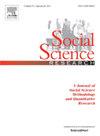网络社会阶层线索与就业能力:来自德国的实验证据
IF 3.5
2区 社会学
Q1 SOCIOLOGY
引用次数: 0
摘要
社交媒体平台,如Twitter或Instagram,为雇主在评估职位候选人时提供了很容易获取的信息——无论相关与否。特别是,它们往往是关于个人兴趣和休闲活动的信息来源。因为兴趣是由社会阶层高度划分的(例如,参与高雅和低俗的活动),这代表了阶级在招聘过程中潜在体现自己的一种新方式。为了研究基于在线社会阶层线索的招聘歧视,我们在德国进行了一项预先注册的调查实验,以雇主和非雇主为样本,操纵求职者在社交媒体上的阶级线索(高雅与低俗)。总的来说,我们发现候选人在社交媒体上展示高雅活动和低俗活动的偏好没有差异。然而,这掩盖了类的特定活动代理中的重要差异。当这些活动与所申请的工作无关时,更高级的候选人会被优先考虑。探索性分析表明,受访者更有可能对更高层次的形象表达积极的情绪,高雅的活动与工作相关的特质呈正相关。我们的研究结果强调,有必要考虑数字环境,更具体地说,网上的社会阶级线索,可能会导致招聘中的阶级偏见。本文章由计算机程序翻译,如有差异,请以英文原文为准。
Online social class cues and employability: Experimental evidence from Germany
Social media platforms, such as Twitter or Instagram, offer easily accessible information – relevant or not – for employers when evaluating candidates for a position. In particular, they tend to be sources of information about individuals’ interests and leisure activities. Because interests are highly stratified by social class (e.g., engagement in highbrow and lowbrow activities), this represents a new way for class to potentially manifest itself in the hiring process. To study discrimination in hiring based on online social class cues, we conducted a pre-registered survey experiment in Germany with samples of employers and non-employers, manipulating job applicants’ class cues on social media (highbrow versus lowbrow). Overall, we found no difference in preferences for the candidates displaying highbrow and lowbrow activities on their social media profiles. However, this masks important differences in the specific activities proxying for class. When these activities have no relevance for the jobs in question, higher-class candidates are preferred. Exploratory analyses show that respondents are more likely to express positive sentiments toward the higher-class profiles, with highbrow activities being positively associated with work-related traits. Our findings highlight the need to consider how digital environments and, more specifically, online social class cues, may contribute to class bias in hiring.
求助全文
通过发布文献求助,成功后即可免费获取论文全文。
去求助
来源期刊

Social Science Research
SOCIOLOGY-
CiteScore
4.30
自引率
4.00%
发文量
0
审稿时长
65 days
期刊介绍:
Social Science Research publishes papers devoted to quantitative social science research and methodology. The journal features articles that illustrate the use of quantitative methods in the empirical solution of substantive problems, and emphasizes those concerned with issues or methods that cut across traditional disciplinary lines. Special attention is given to methods that have been used by only one particular social science discipline, but that may have application to a broader range of areas.
 求助内容:
求助内容: 应助结果提醒方式:
应助结果提醒方式:


